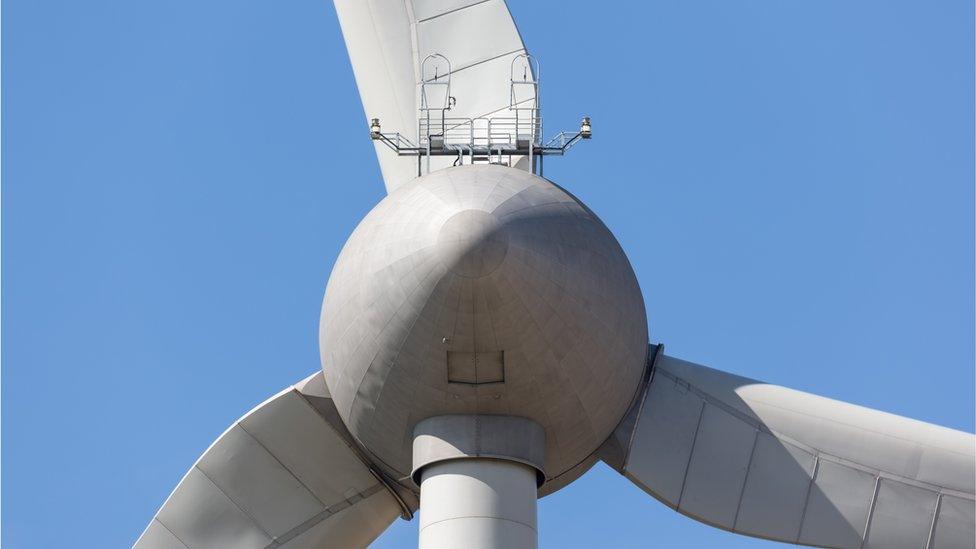Lubricating the economy
- Published
Oil prices have been rising. Their future direction depends on Iran, Trump and OPEC, with the exporter cartel meeting this weekend.
The UK offshore sector has seen big flows of new types of investment, seeking to continue big cuts in the cost of production.
If the offshore sector can halve its cost per unit of production, what lessons could it teach the rest of the economy?

I filled up my first £80 tank of diesel the other day. I'm not saying this in expectation of either applause or sympathy. In part, it reflects the fact that I'd run unusually close to emptying the tank.
It's also because prices have been rising, both because the raw material has seen a boost, and as the pound's strength, or lack of it, against the dollar.
The AA says this weekend that prices could soon be falling again. Margins on refining are falling, it claims.
But it may have issued that opinion before Theresa May's speech on Friday took nearly 2 cents off the US value of a pound sterling.
Meanwhile, uncertainty about the future of oil exports from the Middle East helped push the price of Brent Crude close to $80. It's nudged that level three times this year, not having been close to it for four years. So prices could also go up.
The uncertainty on price largely revolves around OPEC. Iran faces a return to blocked exports, due to US sanctions, and as the third biggest producer in the region, after Saudi Arabia and Iraq, that makes a significant difference.
This weekend, an informal meeting of OPEC energy ministers is reported by Reuters to be considering a plan to boost production, meaning the price would come down a bit. That report checked the upward momentum on Brent crude, reaching the weekend at $78.80.
Gas-guzzlers
In the sort of confusion that is a hallmark of Donald Trump's approach to the international economy, his move to isolate Iran, cutting export supplies and thus putting prices up, was accompanied by pressure - through Twitter of course - on its regional rival Saudi Arabia to bring prices down.
Speaking to his voters, who don't like the rising price of gasoline in their guzzlers (and they really don't like them in the run-up to mid-term elections) he may be less aware that the US oil and gas industry wants higher and stable prices so that it can exploit enormous new opportunities for shale fracking.

The rise from a $30 low point in the benchmark price of oil has brought a lot of activity back to Texas and the Dakotas.
The challenge for much of the US industry now is getting that energy to its end destination. Without pipeline networks for these new production sites, it has to be trucked or it has to be stored.
Flow of funds
There's also a lot more going on in the UK offshore oil and gas industry - not so much drilling, but significant trading of assets.
Private equity funds are flooding into the sector, this week seeing Japan's Itochu conglomerate sell $400m of assets - mainly west of Shetland, and some already in production - to the new, Aberdeen-based Verus Petroleum. It is backed by Norwegian private equity.
Wood Mackenzie, the global energy consultancy based in Edinburgh, last month published an analysis of the inflow of private equity funds into the European industry.
Until the oil price fall starting in summer of 2014, private equity deals were minimal in Europe, but a big feature of the US scene.
With more attractive asset pricing as the industry slumped, and greater clarity on decommissioning liabilities, private equity got to work from 2014 behind new or small drillers you've probably not heard of; Siccar Point, Neptune, HitecVision, Chrysaor, Azinor Catalyst, Var Energy, Zennor and Point Resources.
Together, it's reckoned, their assets will contribute 550,000 barrels to UK production during this year. Siccar Point is the one that's made the biggest splash, with successful exploration wells West of Shetland.
The biggest such private equity deal, struck early last year, was Shell's $3 billion sale of assets to Chrysaor. In total, it's reckoned $12bn has been spent on acquisition, with a further $13bn possible.
What are they there for? WoodMac answers: to exploit, to optimise production while lowering costs, or, to a lesser extent, taking the risky exploration road. Their funding is through debt, loans from the vendors or future payments dependent on results. And to raise funds, they all need exit plans, which is thought most likely to be stock market floats. In one words, there's no one strategy that fits them all.
Rotor rotas
The lack of drilling in UK waters is the major concern in the recently-published annual economic report from the Oil and Gas UK industry body. Without new reserves being found, the decline of output will be much faster than if there were replacement fields.
With North Sea fields slowing up considerably, a high proportion of UK production is from fields brought on-stream in recent years.
Another figure that got less attention from that economic review was the average cost of producing a barrel, at $15.
That has halved since 2014. We've seen that 50% target coming, but it's worth dwelling for a moment on what it represents. It is, we're told, the biggest such cut of any oil and gas producing basin in the world over recent years.
First, the hugely inefficient profligacy of the boom years, when it seems energy companies were spending far more than they needed, and when prices of contractors and equipment were inflated. It's a boom and bust business cycle.
Second, it has been achieved at a high cost in jobs, and in pay and conditions on many jobs. The shift from two-weeks-on-two-weeks-off to a three-week rota brought a big saving in transport costs, which was particularly helpful when the helicopter fleet has been the subject of technical concerns.
Around 56% of offshore workers are now doing three week turnarounds, up from 17% in 2007. That's according to Unite the union, and members don't like the change. Strikes, or the threats of strikes, have become a feature of recent months.
Unlocking stranded assets
There's a lesson that should NOT be taken from the ability to produce the average barrel of oil (or its gas equivalent) for around $15. The difference between that and nearly $80 a barrel is not all profit. It only covers the cost of production, not the cost of exploration and development. And it's worth noting also that it is an average. The cost in different fields varies very widely.
Oil and Gas UK says that the production cost per barrel in 2014 was as high as $100 for the biggest-spending company (it's not naming names), and that maximum has fallen to $35. Meanwhile, the lowest production cost per barrel has been around $6.
West of Shetland is pricey to develop, but with potentially big rewards. WoodMac, in another report this month, suggested four fields in that area are going to drive UK production through next decade; Clare Ridge, Clair South, Cambo and Rosebank.
It says the area is "under-explored", in that it has had less than 160 exploration wells drilled, whereas the North Sea has seen more than 500.
The key, it says, is to get the pipeline infrastructure in place to unlock 'stranded' assets. And, says analyst Kevin Swann, "fractured basement is the big wildcard". That is: the geological formations in that area could be trapping huge amounts of gas or oil in pockets.
Getting at them is the tricksy challenge, and the Lancaster field owned by Hurricane Energy (it has a thing about RAF-related names) should be coming on stream early next year, as a much-watched guide to how well it's going to work.
Gas-to-wire
But there's another lesson from the halving of the cost of producing oil and gas. It is possible to have a dramatic effect on productivity, if you have effective managers and some co-ordination at a regulatory level to make it happen.
The new Oil and Gas Authority has been active on the latter front, requiring companies to work together on efficiency, cost-reduction and co-ordination of ageing assets.

Last week, it published a report urging companies to make use of an offshore wind opportunity.
With only 40% of the cable capacity utilised due to intermittent wind speeds, it's being suggested that electricity could be generated by installing gas turbines out at sea, which would then be sent to the mainland 'gas-to-wire'.
Blame the bosses?
A recent report into productivity, carried out by the Edinburgh-based David Hume Institute think tank, offered some international perspectives on the kind of things that will be required if Scotland is to move from a dismal position on productivity to a competitive one.
It pointed out that comparing itself with the rest of the UK is short-sighted: the UK figure is also poor, and it's been stagnant.
The countries and cities that have seen strong improvements in productivity have had a number of factors in common: cross-party consensus helping with a long-term approach, strong institutions, policy based on evidence.
It may also be that they have better management. That is one factor behind the UK's poor productivity figures that might be worth a much closer look.
Do the right people get promoted into management positions? And if they do, are they equipped with the right motivational skills and mindset to make the most of the skills and capabilities of the people they manage?
Almost certainly not. So what could we do about it? Maybe those engineers in the offshore energy industry could help answer that question.